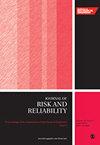Combining first prediction time identification and time-series feature window for remaining useful life prediction of rolling bearings with limited data
IF 1.8
4区 工程技术
Q3 ENGINEERING, INDUSTRIAL
Proceedings of the Institution of Mechanical Engineers Part O-Journal of Risk and Reliability
Pub Date : 2023-01-12
DOI:10.1177/1748006x221147441
引用次数: 2
Abstract
Limited data are common in the problem of remaining life prediction (RUL) of rolling bearings, and the distribution of degradation data of rolling bearings under different working conditions is quite different, which makes it difficult to predict the RUL of rolling bearings with limited data. To address this issue, this study combines first prediction time identification (FPT) and time-series feature window (TSFW) for predicting the RUL of rolling bearings with limited data. Firstly, the proper first prediction time is identified by a novel FPT identification method considering root mean square and Kurtosis simultaneously. Subsequently, to accurately capture the sequential characteristics of bearing degradation data, the TSFW is constructed and then adaptively compressed considering degradation factor that is derived mathematically. Based on this, this study employs multi-step ahead rolling prediction strategy with degradation factor from FPT to reveal the future degradation trend and then predict the bearing RUL. Finally, the feasibility and generalization of the proposed method under limited data is validated by carrying out several rolling bearing experiments, and the prediction errors for two representative bearings are 14.46% and 8.06%.结合首次预测时间识别和时间序列特征窗的有限数据滚动轴承剩余使用寿命预测
在滚动轴承剩余寿命预测(RUL)问题中,数据有限是常见的问题,不同工况下滚动轴承退化数据的分布差异较大,这使得用有限数据预测滚动轴承的RUL变得困难。为了解决这一问题,本研究结合了首次预测时间识别(FPT)和时间序列特征窗口(TSFW)来预测有限数据下滚动轴承的RUL。首先,采用一种同时考虑均方根和峰度的FPT识别方法,确定合适的首次预测时间;然后,为了准确捕捉轴承退化数据的序列特征,构建TSFW,并考虑数学推导的退化因子进行自适应压缩。在此基础上,采用基于FPT退化因子的多步超前滚动预测策略,揭示未来退化趋势,进而预测轴承RUL。最后,通过多次滚动轴承实验验证了该方法在有限数据下的可行性和泛化性,对两种代表性轴承的预测误差分别为14.46%和8.06%。
本文章由计算机程序翻译,如有差异,请以英文原文为准。
求助全文
约1分钟内获得全文
求助全文
来源期刊

Proceedings of the Institution of Mechanical Engineers Part O-Journal of Risk and Reliability
ENGINEERING, MULTIDISCIPLINARY-ENGINEERING, INDUSTRIAL
CiteScore
4.50
自引率
19.00%
发文量
81
审稿时长
6-12 weeks
期刊介绍:
The Journal of Risk and Reliability is for researchers and practitioners who are involved in the field of risk analysis and reliability engineering. The remit of the Journal covers concepts, theories, principles, approaches, methods and models for the proper understanding, assessment, characterisation and management of the risk and reliability of engineering systems. The journal welcomes papers which are based on mathematical and probabilistic analysis, simulation and/or optimisation, as well as works highlighting conceptual and managerial issues. Papers that provide perspectives on current practices and methods, and how to improve these, are also welcome
 求助内容:
求助内容: 应助结果提醒方式:
应助结果提醒方式:


